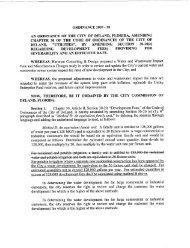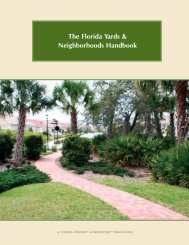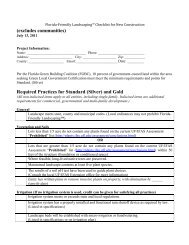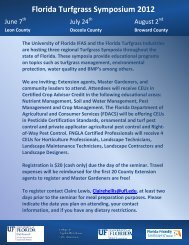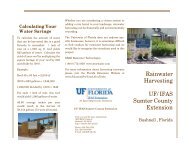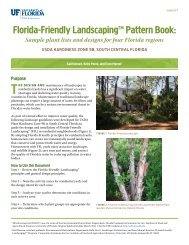promotes deeper rooting, which is one of the keymechanisms of stress tolerance for turfgrasses.• Reduce fertilizer applications to turf growing inshade. The grass grows more slowly in a shaded environment,which reduces fertility needs. Too muchnitrogen fertilizer depletes carbohydrates and producesa weaker turf system. If you normally apply 4 poundsof nitrogen per 1,000 square feet yearly, apply 2.5 to 3pounds to turf growing in the shade. Limit any singlefertility application to no more than 0.5 pounds ofnitrogen per 1,000 square feet at any one time.• Water use is substantially reduced under shaded conditions,so adjust irrigation accordingly. If the irrigationsystem covers an area that is partially shaded andpartially in sun, consider removing the sprinkler headsfrom the shaded areas and irrigate by hand when rainfallis inadequate.• Avoid the effects of vehicle and foot traffic. The grassis more easily injured by traffic if growing in shade,and may not be able to recover adequately. Also, trafficin shady areas may damage a tree’s roots, resulting inthe decline or death of the tree.• Monitor for weed pressure. Weeds are able to outcompeteturf in certain situations, and will seek out thoseopportunities. In a shaded environment, lateral turfgrassgrowth and ground cover may be sparse, leavingbare ground suitable for certain weeds. Treatment witha pre- or post-emergence herbicide may be necessary.Use caution, however, when applying any chemicaltreatment to a shaded lawn, as there is a greater chanceof phytotoxicity (toxicity to plants) when a grass isunder stress. Also, many herbicides can damage landscapetrees and shrubs.• Monitor for disease pressure. In many shaded environments,there is less air movement and more humidity,which may increase the possibility of disease. Again,use caution if applying pesticides to a turf that isalready under environmental stress.In particularly troublesome areas, consider other groundcovers besides turf. Examples include ivies (Hedera spp.),liriope (Liriope spp.), mondo grass (Ophiopogon spp.), andAsiatic jasmine (Trachelospermum asiaticum).Remember, the key to a successful landscape is “RightPlant, Right Place.”10FLORIDA FRIENDLY BEST MANAGEMENT PRACTICES for Protection of Water Resources by the <strong>Green</strong> <strong>Industries</strong>
Chapter 3: Irrigation <strong>Best</strong> <strong>Management</strong> <strong>Practices</strong>Using proper irrigation system design, installation,management, and maintenance practices provides amultitude of benefits. These benefits include savingmoney, using irrigation efficiently, a healthy and moredrought and pest-resistant landscape, and protecting thestate’s water resources. <strong>Green</strong> Industry workers need tobe aware of the different irrigation processes and systemcomponents because irrigation is a major factor in thesuccess of their industry. By understanding the irrigationsystem, they can save the company and the clientmoney and help protect ground water supplies andwater quality.This section of the document includes background informationand irrigation BMPs for the <strong>Green</strong> Industry.Some of the BMPs mentioned are not usually consideredthe responsibility of mowing and trimming services orroute based service businesses. However, many <strong>Green</strong>Industry workers, who may be directly employed byproperty owners, associations or municipalities, are oftenresponsible for operation and maintenance of an irrigationsystem. For complete BMPs specific to the IrrigationIndustry please refer to:• Florida Irrigation Association (www.fisstate.org)• Irrigation Association (www.irrigation.org)• The University of Florida’s Institute of Food andAgricultural Sciences (IFAS) (http://edis.ifas.ufl.edu/)Irrigation is an age-old art and is defined as the applicationof supplemental water to a soil for plant growth. Italso provides a mechanism for nutrients to move from thesoil into a plant. Other uses include salt leaching, chemigation,system flushing, seed germination, and climatemodification.On average, Florida receives more than 50 inches of rainper year. However, the distribution and amounts of thisrainfall are not always adequate to meet a plant’s waterdemands. Providing the amount of water that a plantneeds at the correct time is the key to resource conservation,reduced pollutant loading, and optimum plantgrowth.This chapter describes irrigation concepts to help explainthe fundamentals of good irrigation. The green industrycan use this information to assist them in their dailyoperations and to help their clients to save water, improveplant health and reduce the flushing of fertilizer nutrientsfrom a plant’s root zone. In addition, this chapter identifiesspecific irrigation BMPs for the <strong>Green</strong> Industry.Throughout the chapter, the term “plant” refers to bothturf and landscape plants, including trees.PERMITTING AND REGULATIONSMany agencies have jurisdiction over an irrigationproject before, during, and after construction. Forexample, Florida’s five water management districts,Florida Department of Health, Florida Department ofEnvironmental Protection, or local governments mayrequire well permits. Typically, for large projects thewater management districts issue water use permits,which are usually calculated for drought conditionsrather than for normal irrigation. To prevent potentialfines, it is important to identify and abide by all regulatoryrequirements.Besides water use permits, some water managementdistricts have special year-round water conservationmeasures and drought/water shortage restrictions thatgovern the amount and timing of irrigation. It is importantto know the restrictions for a site and to settimers/controllers to those conditions. Since watershortage restrictions change with the severity of adrought, it is important to be aware of and to abide bycurrent restrictions. If a site’s irrigation system cannotbe adjusted to meet the restrictions, the system shouldbe upgraded as soon as possible, but in the interim,there are methods to obtain variances. These variancesneed to be obtained in writing, before irrigating.Since 1991, Florida Law has required an operatingrain-activated cutoff switch on all automaticallycontrolled irrigation systems. In 2004, the Floridalegislature created section 373.228 Florida Statutesdirecting the Department of Environmental Protection,373.62 Water conservation; automatic sprinkler systems.Any person who purchases and installs an automatic lawnsprinkler system after May 1, 1991, shall install, and mustmaintain and operate, a rain sensor device or switch thatwill override the irrigation cycle of the sprinkler systemwhen adequate rainfall has occurred.the Water <strong>Management</strong> Districts, and several stakeholdergroups to devise standards for Landscape Irrigation andFlorida-Friendly landscape design. These standards wereadopted in December 2006. Local governments must usethese standards when adopting local ordinances after thatdate. The irrigation standards are based on Appendix Fof the Florida Building code. See the shadow box in theIrrigation Design section for more details.The following permitting and regulatory guidelinesshould be followed for all irrigation projects:• Contact local and state regulatory agencies (such asthe county, city, Florida Department of EnvironmentalDepartment of Environmental Protection – Revised DECEMBER 200811
- Page 3 and 4: GOALS OF THE MANUALThis manual prov
- Page 5 and 6: Table of ContentsGOALS OF THE MANUA
- Page 7 and 8: Chapter 1: IntroductionUSING BEST M
- Page 9 and 10: these is performed properly, the ne
- Page 11: BMPs, job safety, and the specific
- Page 14 and 15: compacted by construction activity?
- Page 18 and 19: Protection, water management distri
- Page 21 and 22: IRRIGATION SYSTEM INSTALLATIONOnly
- Page 23 and 24: tion promotes deeper root developme
- Page 25 and 26: GREEN INDUSTRY IRRIGATION BMPSThe p
- Page 27 and 28: MOWING THE FLORIDA LAWNMowing is an
- Page 29 and 30: MANGROVESThree species of mangroves
- Page 31 and 32: Chapter 5: FertilizationFERTILIZER
- Page 33 and 34: cases, these stabilized N materials
- Page 35 and 36: influences the activity of the soil
- Page 37 and 38: nitrogen restrictions discussed ear
- Page 39 and 40: impervious surface that drains to a
- Page 41 and 42: The P content of the fertilizer sho
- Page 43 and 44: plastic container, mix them thoroug
- Page 45 and 46: think that less fertilization is al
- Page 47 and 48: help to establish proof of proper u
- Page 49 and 50: The best way to manage pesticide st
- Page 51 and 52: Segregate herbicides, insecticides,
- Page 53 and 54: pressure, size of nozzle, and spaci
- Page 55 and 56: MANAGEMENT OF PESTS IN THE LANDSCAP
- Page 57 and 58: ReferencesUnless otherwise mentione
- Page 59 and 60: Pruning Shade Trees in the Landscap
- Page 61 and 62: APPENDIX A: IMPORTANT TELEPHONE NUM
- Page 63 and 64: APPENDIX B: FLORIDA COOPERATIVE EXT
- Page 65 and 66: APPENDIX C: RULE 5E-1.003(2) LABELI
- Page 67 and 68:
EMERGENCY REPORTING TELEPHONE NUMBE



